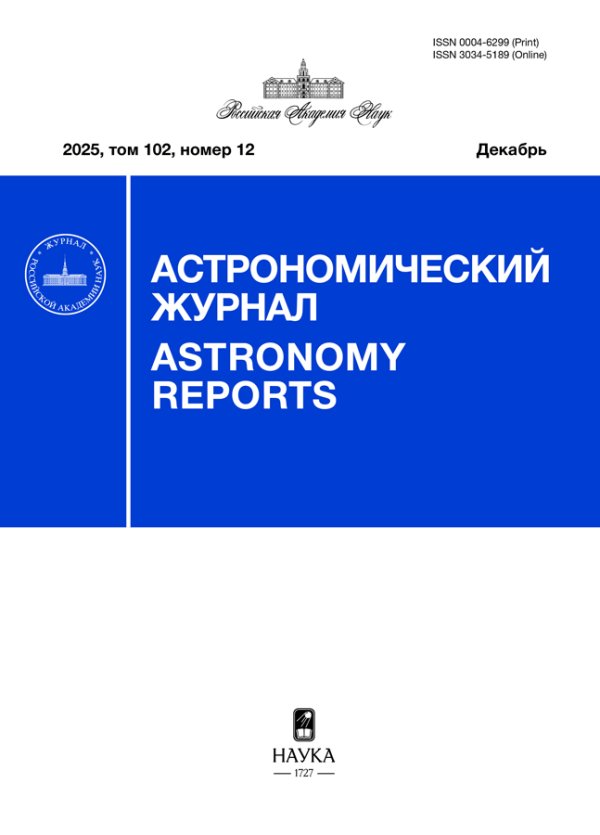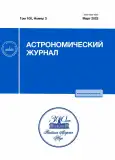Vol 100, No 3 (2023)
Articles
Large-Scale Convection during Gravitational Collapse with Neutrino Transport in 2D and 3D Models on Fine Grids
Abstract
The problem of the gravitational collapse of the core of a massive star is considered, taking into account the neutrino transport in the flux-limited diffusion approximation. To reduce the computational domain of a multidimensional problem on a fixed computational grid, the core of a star, which is already at the stage of collapse, is considered. Since the collapse stage is delayed in time compared to the gas-dynamic time scale for an emerging proto-neutron star, we consider the mathematical problem for the initial configuration in equilibrium and neglected the initial radial velocity. Pressure for a long time at the collapse stage is provided by relativistic degenerate electrons, so the relationship between pressure and density in the initial configuration is described by a polytropic equation with the polytropic index n=3. The purpose of this paper is to test the hypothesis that large-scale convection is independent of the 2D and 3D geometry of the mathematical problem and computational grid parameters, as well as the choice of the initial stage of gravitational collapse. The scale of convection is determined by the size of the region of decreasing entropy with neutrino losses, i.e., nonequilibrium neutronization, and the presence of a weak initial rotation.
 221-232
221-232


Observations of Hydroxyl in the Onsala 1 Source at 18 cm
Abstract
We present results of polarization observations of the ON 1 source in the 1665, 1667, and 1612 MHz hydroxyl lines at the Large Radio Telescope in Nançay (France). Spatial identification of the spectral features of OH in the 1665 and 1667 MHz lines with maser spots (condensations) on the VLBI map according to the data of Fish et al. (2005) was carried out. Emission from hitherto unknown spectral features in the 1665 MHz main line at radial velocities of –2.98, 9.35, and 11.8 km/s has been detected. Five Zeeman pairs were found: four in the 1665 MHz line and one in the 1667 MHz line. The vectors of the transverse magnetic field H⊥ are oriented mainly along the arc (in the upper and lower parts of the UC H II region), while the vectors of the longitudinal magnetic field H|| in the northern and central parts of the UC H II region are oriented away from the observer, while in the southern part toward the observer.
 233-242
233-242


A Study of Variability of the Stokes Parameters and the Magnetic Field of G43.8–0.1 in the OH Line 1665 MHz
Abstract
We present results of the study of maser emission variability in the 1665 MHz OH line in the G43.8–0.1 star formation region based on observations (monitoring) in 2008–2022 at the Large Radio Telescope in Nancy (France). Variability of all polarization parameters of the majority of spectral features, which has a monotonic regular character, has been found. Spatial identification of the main spectral features of the OH 1665 MHz line with maser spots (condensations) on the VLA map has been carried out. For the Zeeman pair VLSR=44.15 km/s, a monotonic change of the splitting with time during 2008–2022 was found and, consequently, a change of the magnitude of the longitudinal magnetic field. According to our calculations, at the end of 2012, the direction of the magnetic field changed to the opposite. Сorrelated with H∥, there were changes in the angle χ and, as a consequence, changes in the direction of the vector of the transverse magnetic field H⊥0. For the maser feature at 44.5 km/s, a change of H⊥ by 180° was found. In 2016–2022, some reorientation of the global magnetic field (H⊥) in G43.8–0.1 occurred. The field became less chaotic: in the eastern part, the field in maser condensations is perpendicular to the arc, and in the western part, it is parallel to the arc. It is assumed that the global magnetic field in the entire U H II region of the G43.8–0.1 source has the same direction: along the axis (northeast)—(southwest).
 243-257
243-257


On the Question of the Primordial Helium Abundance by the RRL Observations in Orion A
Abstract
Radio recombination lines comprise a powerful tool for studying the interstellar medium. One of the important tasks is to measure the primordial abundance of helium formed during the primordial nucleosynthesis of the Universe, which, in turn, allows us to verify the conclusions of the Standard Cosmological Model. The Orion A nebula is an interesting object for studying this problem. Previously, we found that, in this HII region, the region of ionized helium is smaller than the region of ionized hydrogen. Therefore, the actual helium abundance, n(He)/n(H), is not less than the maximum measured value of y+ = n(He+)/n(H+). This makes it possible to obtain restrictions on the primordial helium abundance. This article presents new observations of radio recombination lines in Orion A at a wavelength of 13 mm. It was found that the maximum value of y+ is in the range 10.03–11.55%. Therefore, it can be expected that the primordial helium abundance (Yp, He/H mass ratio) can be not less than ≈24.93–29.40%, which allows deviations from the conclusions of the Standard Model; for instance, it allows the presence of unknown light particles during primordial nucleosynthesis. Observations of doubly ionized helium in Orion A and the planetary nebula NGC 7027 were also made. It was found that the contribution of doubly ionized helium, y++ = n(He++)/n(H+), is <7 × 10–4 in Orion A and 2.7(±1.3)% for NGC 7027. Estimates of the electron temperature are also made. In particular, for NGC7027, it was found that Тe ≈ 11 900–12 300 K, which is higher than for the HII regions.
 258-271
258-271


Analysis of the Parameters of Radio Pulsars with Giant Pulses Using the Principal Component Analysis
Abstract
Clustering of radio pulsars with observable giant pulses (GPs) has been carried out using the principal component analysis. Five parameters were used (period, its derivative, observed luminosity, kinematic age, and the angle between the rotation axis and the magnetic moment of the central neutron star). It was shown that the set of all known GP pulsars is divided into two clusters in the phase space of the principal components. One of the clusters contains four pulsars with short periods and high luminosity; the second cluster contains nine long-period and fainter sources. A separate object, not included in these two clusters, is the pulsar in the Crab Nebula. Possible models that could explain the observed difference between GP pulsars were considered.
 272-280
272-280


Modeling of Absorption in the Hα Line for the Exoplanet WASP-52b
Abstract
The results of modeling the Hα absorption spectrum of the atmosphere of the hot Jupiter WASP‑52b are presented. The atmosphere was modeled with a three-dimensional hydrodynamic code. Several different values of the XUV ionizing radiation were considered. The Lyα-photon transfer in the atmosphere was simulated by the Monte Carlo method. Spatial distributions of the volume density of hydrogen atoms excited to the second energy level H(2) were obtained, and absorption spectra in the Hα line were calculated. It was also shown that absorption takes place in a layer with a thickness of about 1.5 times the planetary radius, while the greatest influence on absorption is exerted by Lyα photons produced due to recombination of electrons and protons.
 281-288
281-288


Search for Solar Sources of Interplanetary Coronal Mass Ejections Using the Reverse Model of Magnetodynamic Interaction of the Solar Wind in the Heliosphere
Abstract
In the development and testing of methods for predicting interplanetary coronal mass ejections (ICMEs), it is important to establish their relationship with sources on the Sun—coronal mass ejections (CMEs) observed by coronagraphs. The often used inverse ballistic calculation of the CME onset time does not consider variations in the CME speed when moving through the heliosphere and can give an uncertainty up to a day. With a good accuracy (on the order of ±10 h), the propagation of CMEs in the heliosphere from the Sun to the Earth is described by the model of the magnetodynamic interaction of CMEs with the background solar wind (drag-based model, DBM). In this paper, we propose to search for possible coronal sources of ICMEs, observed near the Earth, using the reverse model of magnetodynamic interaction (reverse DBM, RDBM), which reconstructs in the reverse course the probable propagation of CMEs in the heliosphere and determines their outflow parameters in the solar corona using the measured ICME parameters. The model uses the speed of the background solar wind, which is calculated from the area of coronal holes in the central part of the Sun and presented on the website of the Space Monitoring Data Center of the Skobeltsyn Institute of Nuclear Physics, Moscow State University (SINP MSU), with correction factors.
 289-296
289-296


GAIA Arguments for and against a Hypothetical Sun Companion
Abstract
The hypothesis that the Sun is a component of a binary star system has been around for about a hundred years. Assumptions about the nature of the companion continue to be published as new observational data become available. The paper shows that the results of the work of the Gaia space observatory impose certain restrictions on the nature and location of the companion. The fact that the companion is not registered by the observatory leaves the following marginal possibilities: a cool brown dwarf (Y3 and later) in an orbit inside the Oort cloud, or an L/T brown dwarf in a higher orbit (from a≈ 105 AU). At the same time, the companion is quite likely cataloged in the 2MASS and WISE surveys. We also provided estimates for the absolute G-magnitudes of brown dwarfs of late spectral types.
 297-302
297-302












